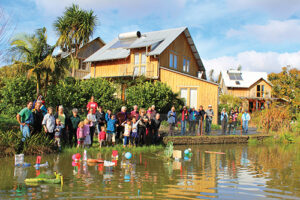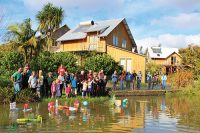 Excerpted from the Summer 2018 edition of Communities, “Eco-Building”—full issue available for download (by voluntary donation) here.
Excerpted from the Summer 2018 edition of Communities, “Eco-Building”—full issue available for download (by voluntary donation) here.
“Mmmm, what’s that beautiful smell?” asked the young visitor to Earthsong as she came into the common house, looking around with a small wondering smile.
I ceased noticing the subtly fragrant, slightly spicy smell soon after moving into my new house in this cohousing community, but it is a typical first response of visitors. Earthsong houses smelt beautiful from the beginning, a combination of the resins of the solid timbers, and the natural tung tree oil and citrus thinners applied to the timber. Standard new construction often smells strongly of chemicals and can precipitate a headache within minutes. Our noses are highly sensitive organs that have evolved over millennia to give us information about our environment, and especially if something is healthy for us or not. Trust your nose!
Earthsong Eco-Neighbourhood is a 32-home cohousing community in Auckland, New Zealand. A fundamental part of our vision was to build to the “highest practical standards of sustainable human settlement.” We chose materials that best fitted a range of sustainable criteria, including local and renewable where possible, low environmental impact and embodied energy, low toxicity, naturally durable, preferably reusable and recyclable.
But is it possible to use healthy and sustainable building materials in cohousing and still stay affordable? Does the group consensus process inevitably lead to compromises in green building decisions, or can it enable more courageous choices than a single household might consider? How much risk should a cohousing group take in trying less standard construction methods in order to build green? Earthsong faced these and other conundrums in our determination to be good neighbours to ourselves and the planet.
Appropriate sustainable building materials don’t have to be expensive; many simple and effective solutions can be found using materials close to their natural state; cheap, beautiful, and sustainable. The rammed earth walls, solid timbers, natural oils and paints, and other sustainable materials at Earthsong have created a beautiful and healthy neighbourhood.
Innovative natural building materials are more typically used by owner-builders or passionate small-scale artisans building single homes. Owner-builders can respond to opportunities of material supply. They are willing to experiment, modify techniques on the job, and most importantly, they are willing to live with the (not always successful) consequences of experimentation.
Applying these same materials and systems to higher density multi-unit developments built by contractors in a profit-driven environment raises different issues and challenges. Commercial developers of multiple-unit developments look for design and materials acceptable to mainstream buyers. They value consistency of supply and reliable cost, and need a choice of contractors and tradespeople skilled in working with the materials for competitive tenders. They prefer no surprises in construction, and want predictable performance of materials so there are minimal “call-backs.”
At Earthsong we operated in both of those worlds. We wanted to build a multi-home housing development, and we were a group of individuals with passion and drive and willing to innovate. We wanted to use natural and sustainable materials, and we needed a financially viable and cost-effective development. We set up a nonprofit company to be our own developer, and were willing to make braver choices than a commercial developer. And it was challenging!
If we want sustainable nontoxic materials to come into more mainstream use, it’s essential that we talk about the challenges and learn from experience; even, or maybe especially, when it has been painful. Here are some of the challenges we found using natural building techniques for production housing. Some of these would apply also to one-off homes, but the logistics can get much more complicated with larger scale projects.
Craftsperson building techniques applied to production housing
In multi-unit housing, most would expect cost savings with repetition of design and processes and bulk buying of materials. This did not really eventuate in our case, because with rammed earth walls, timber structure, and lots of solid timber joinery and linings, they are crafted houses with a high skill and labour content.
One can argue, however, that using highly skilled labour is more sustainable and socially beneficial than using highly manufactured materials. Skilled labour usually makes possible the use of less processed materials with a lower embodied energy and shorter travel distances. Builders working with natural materials take pride in their work, and their skills are visible and valued. Skilled builders can respond to opportunities, working with the variable natural material to create something special.
Working with natural materials is usually healthier for the builders, and much more satisfying than the standard high-volume low-skill technology that relies on fossil energy use and highly manufactured products. Builders run on sandwiches, not fossil fuels!
Scale and density
With 32 houses on 1.2 hectares (three acres), Earthsong is considered a medium density development, and this affected both the design (two-story attached dwellings) and the means of construction (clusters of dwellings built by a single contractor). While it was not possible for individual owners to build their own houses, we did build in stages of two or more attached clusters.
Attached houses require good fire and acoustic separation between them. Rammed earth construction is brilliant for both; very little sound and no fire gets through solid earth construction. The upstairs timber-framed walls between houses, using standard detailing for party-walls, also presented no problems. What was more challenging was the external timber board-and-batten weatherboards on the upstairs walls. After much discussion with the local consenting authority to achieve sufficient fire separation between units, they accepted the external timber cladding with a small nib wall between houses to push any flame from one house away from the next.
Earth walls usually require a “good hat” to keep the high New Zealand rainfall off the walls. Two-story houses meant that the shelter of the roof was well above the ground-floor earth walls. Portland cement and agricultural lime aggregate was added to the rammed earth mix to improve durability and resistance to water penetration. In the later houses, small roofs or “hoods” were built above the earth walls to give local shelter.
Limited choice of building contractors
Any large building project requires contractors skilled in using the materials and systems involved. Because we were using non-standard eco-friendly materials and construction systems, there was only one company at the time skilled in rammed earth and of sufficient size to handle our project, so a competitive tender process was not feasible. Instead we worked early with the identified company to incorporate their cost-effective construction details into our design, and negotiated the contract price and conditions. While they were well established in building single rammed earth and solid timber houses, they hadn’t built more than one house at a time, so we hired professional project managers to work alongside and mentor them in the management systems required for such a large project as ours.
However, the unthinkable happened for us when three quarters of the way through building Stage I (the first 17 houses), the construction company found themselves in financial difficulties largely caused by previous jobs and went into liquidation. This was a very serious setback to an already challenging project and we lost a substantial amount of money in delays, complications, and non-delivery of materials that we had paid for in advance.
Fortunately, almost all the rammed earth walls had been completed by then, and we managed to find mainstream builders willing to finish the houses, at great extra cost. We managed financially by deleting all non-essential items from the new contract and enlisting personal pledges from over 30 friends and relations to cover any shortfall at the end. Owners did their own painting, oiling, and sundry other tasks, and paid more for their houses to cover the extra costs. It was very painful, but we managed to pull the project back from the brink.
Supply issues
Many natural building materials are not available “off-the-shelf.” This entails finding a suitable supply well ahead of time, of appropriate quantity and quality, and often committing money up front to secure, and sometimes to process, that supply.
Timber was our biggest supply problem. Our houses have a lot of internal and external timber, all untreated and naturally durable species not readily available in bulk. In Stage I, the contractor proposed buying the living trees (mainly old farm shelterbelts) and getting them milled to ensure supply and save costs. They had to find and buy enough trees of the right species from several different sources, and get them harvested, milled, transported, and stored for seasoning. This required ongoing work for the contractors throughout construction, and upfront money from us to pay for it.
The winter that year was very wet. It was an ongoing problem getting enough of the right species and sizes of timber available and dry enough to use when needed. It created a major nightmare with the timeline, and no doubt contributed to the builders’ troubles. The contractors’ methodology may have worked for them on single house builds, but the logistics of processing the quantities required for 17 houses just proved too difficult. We didn’t have the same supply issues in the later stages of building, however, as the Stage II contractor had a reliable supplier who sourced and supplied the appropriate timber when needed.
Variable materials
Most natural building materials are, by definition, less processed, less homogenized, and more variable. This is part of their charm, but can cause issues in construction, especially when building in bulk with added time and cost pressures. The ramming earth gave us problems late in construction.
Earth or subsoil suitable for ramming contains a range of particle sizes from fine (clay) to coarse (gravel). In some locations this occurs naturally and can be dug straight from the ground. If the local earth is not ideal, it needs additions of sand, lime, or other material to give an appropriate mix.
The earth walls in most of our houses are strong and beautiful. But problems appeared in the last stage of construction, with the walls having a crumbly surface and fine cracking. The strength of these walls was found to be acceptable, though lower than the earlier walls. The real problem was that they absorbed water, which we feared would weaken the walls and result in damp houses. Testing and soil analysis eventually showed that the clay content of the ramming earth had dropped significantly to almost zero. Some clay content is important because clay gives the initial cohesion to the material when the wall is rammed and being the smallest soil particle, helps the wall resist water penetration. In the few weeks between the soil being excavated for the pre-construction test wall and the actual wall ramming, the soil composition in the part of the bank being excavated at the time had changed.
By the time we realised there was a problem, the earth walls of three ground-floor units had already been rammed. Extra hoods were built around the building to protect the lower walls, and an earth wall sealer was used in some locations to minimize dusting and crumbling. Several mixes were trialed with test walls to develop a successful new recipe for the upper walls. It was very stressful and costly in time and money to both the contractor and us. But in this case the contractors worked hard with us to address the problem, and what we learnt has contributed to earth building knowledge in New Zealand.
Unusual design details
The other main area of difficulty and challenge has been in materials incompatibility. One consequence of pioneering new techniques to address environmental aspects of construction is that inevitably some mistakes were made, as other aspects of the materials were not understood or were overlooked. One example was the accelerated corrosion of unpainted zincalume (zinc/aluminium alloy coated steel) roofs through copper-laden runoff from the solar hot water panels. This was annoying but relatively simple to fix by applying protective paint.
Another example was more serious: corrosion of zinc flashings installed at ground level to protect the concrete floor slab insulation in the common house. These ground level flashings required substantial research, redesign, and expensive replacement. This was a painful process that delayed full completion of the common house by nearly two years, but we eventually found a solution that met our criteria of sustainability, durability, and ground-floor accessibility, and the repair was done.
All worth it in the end
This might sound like a litany of woes, but it wasn’t all bad! While some problems were more complex than others, we found solutions for them all and carried on. It was a challenging journey, but we knew the journey was worth making, and we learnt a lot along the way that we can share with others. Few problems are insurmountable, and hopefully our experience will help others to anticipate where problems might occur and to plan ahead, so they don’t trip you up in the heat of construction.
Do we wish we’d chosen more standard construction? No. We have beautiful, solid, timeless buildings, lovely to live in and with good thermal performance. The smell of well-being still infuses our lives 15 years later.
Is it possible to use sustainable materials and stay affordable? Yes. Many sustainable materials don’t cost more than standard materials, although they might require more research and more effort to supply. There will often be a higher labour content, but also lower material and maintenance costs. It’s a different aesthetic. Solid, natural timbers gain character with the knocks of age and use, unlike painted plasterboard which just starts to look shabby. Purchasers paid more money for the added costs of construction challenges, but our houses still ended up affordable relative to the standard housing market, and ongoing running costs for heating and cooling are very much less.
Does group consensus mean compromise, or more courageous choices? This depends on the strength of your vision and group commitment to sustainability. In our case I believe we held each other to account, pushed each other further to uphold our vision than we might have gone individually. The consequences of the difficulties were held by the group, not individuals, and together we stood stronger.
How much risk is reasonable for a group to take on? Again, it’s up to the group to decide. Balance your vision and commitment with sensible, well researched decisions. We went out on a limb by choosing earth building, but it was backed up by solid research and professional support. We certainly had our issues, but those few challenging years have produced lovely buildings that will last generations into the future.
At Earthsong we were committed to making buildings that foster the health and well-being of both the people who occupy them and the global ecosystems of which they are part. We offer our mistakes, successes, and learnings in the hope of encouraging the wider use of natural building materials and systems in cohousing projects.
Robin Allison was an eco-architect before founding and driving the development of Earthsong Eco-Neighbourhood. She now teaches and supports other community projects, and is writing a book of her cohousing experience to be published in 2018. See www.robinallison.co.nz.
Excerpted from the Summer 2018 edition of Communities, “Eco-Building”—full issue available for download (by voluntary donation) here.




















